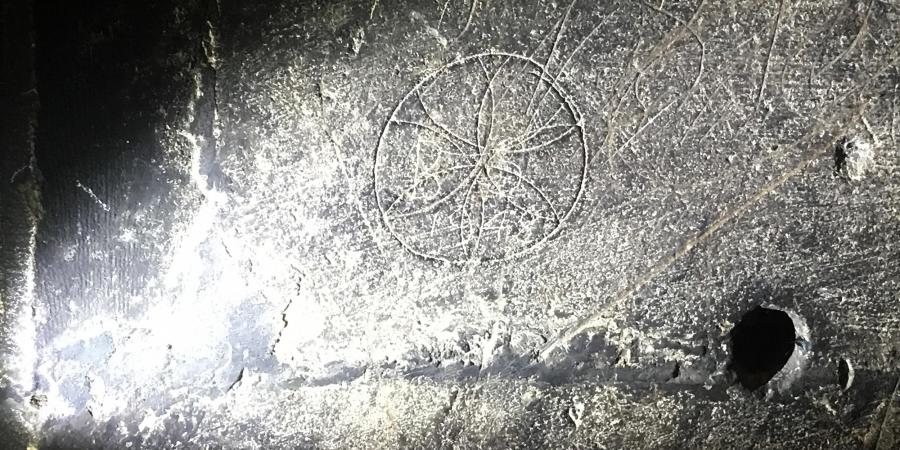During the recent excavations at Bath Abbey, as part of the Foot Print Project, the team noted the presence of Apotropaic marks carved on the building’s fabric. Apotropaic marks were used to protect buildings from evil spirits and witches; the word comes from the Greek term ‘apotropaios’ meaning ‘averting evil’. They are relatively common in Religious Houses, often taking the form of geometric patterns − and are very distinct from Masons Marks and graffiti which are often seen carved into historic buildings.
The fear of the supernatural and evil spells was at its height in England during the 17th century, but many of these symbols are much earlier and can be found in buildings dating from the mid-16th century through to the early 18th century.
The threat posed by ‘evil spirits’ was taken seriously by academics and churchmen as well as the general populace. James VI of Scotland (the future James I of England and Ireland) encountered a dangerous storm at sea in 1589 which threatened to sink his ship. James believed that witches could ‘rayse stormes and tempests in the air’ and that the storm had been an assassination attempt. In the witch-hunt that followed over 300 people were accused of being involved in supernatural plots against the king, including the Earl of Bothwell, who was sent into exile, and his friend Mary Napier, who James had ordered to be burnt at the stake but was fortunately acquitted by the court.

In 1597 James published ‘Daemonologie’, a treatise on black magic, witchcraft and evil spirits.
The fearful abounding at this time in this country, of these detestable slaves
Of the Devil, the witches and enchanters, hath moved me (beloved reader)
To dispatch in post, this following treatise of mine.
In this work James describes how witches could transform into an animal and enter houses or churches ‘by any opening which air may enter’. Thus, doors, windows and fireplaces were seen as the likely points at which evil spirits would enter a building and so this is where the majority of ‘witch’ marks can be found.
Apotropaic marks come in various types but the most common is the ‘daisy wheel’ of concentric circles. One explanation for this design is that the evil spirit would get caught within its concentric rings and not be able to escape.
During recent photographic work within Bath Abbey’s Vestry daisy wheels were recorded on the stone door jamb at the entrance where they had been carved to protect the Vestry.
Further marks have also been discovered amongst large amounts of historic graffiti in the north-east stair turret. One distinctive design here stands out, it has been carved into the top of the stone doorway and has a very distinctive design consisting of three arcs forming what may be interpreted as a Celtic knot. This may be a ‘cross-over’ design with the religious connotation of the ‘Holy Trinity’, but also functioning as a protective mark.


While today these apotropaic marks are no longer in common use, they are still of great interest and give a very real insight into historic conceptions of the supernatural. In the life of the church especially, there has been an immense shift in thinking and such beliefs are no longer the norm.
Revd Stephen Girling, Bath Abbey’s Acting Rector, said: “We see these protective marks as an important part of our history. Today, while Christians acknowledge the presence of the supernatural, we believe that we are protected from evil by obedience to the teachings of Jesus Christ and by prayerful good deeds.”
It is clear that Bath Abbey has a wealth of marks waiting to be discovered. Members of the Wiltshire Field Archaeology Group are working on a major survey to identify and record all the Abbey’s graffiti and to identify and catalogue all the examples of this fascinating phenomena, which forms yet another intriguing layer to this wonderful site’s rich history.
By Bob Davis (Senior Heritage Consultant, Wessex Archaeology)



